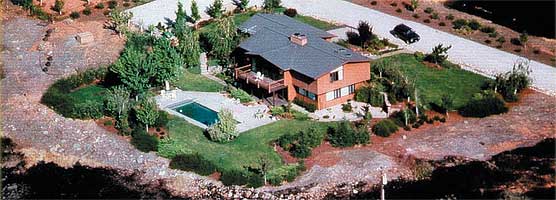Being Fire-Wise: Defensible Space
From Rugged mountains to rolling foothills, majestic forests to green valleys, Idaho offers some of the most diverse landscape in the country and Idahoans have always embraced the unique opportunities to make our homes in these beautiful, unique lands. Since humidity is low and summer months can get quite warm, we are also faced with the very real threat of wildfires.
Year after year, we’ve seen the damage and despair caused by a simple spark or lightning strike, we’ve seen thousands of acres destroyed, and felt the compassion for those who lost homes and even loved ones in these tragedies. But we’ve also seen images of relatively unscathed homes sitting closely beside fire-gutted homes. This isn’t due to luck or the forces of nature, this is the result of being fire-wise.

To be fire-wise you must carry out certain fire protection measures before a fire even starts. By following the following simple fire safety steps, your home will have a chance to survive while firefighters work to bring the wildfire under control. Remember, a fire department’s effectiveness in battling a wildfire starts with you!
What to know:
The first precaution is probably the most crucial step in preparing your home for fire season, and it should be maintained throughout the year, every year. It’s commonly known as “defensible space”: a perimeter around your home free of combustible materials or anything that can become fuel during a wildfire.
Defensible space zones start with your home and move out into the landscape from there. In areas with homes that are close enough to each other, defensible spaces may overlap to provide added protection for the subdivision.

Zone 1: Your Home Eliminate the ignition potential of your home. Pay particular attention to non-flammable roofing, enclosing soffits and overhangs, removing debris from roofs and gutters, and identifying flammable items such as patio furniture, brooms, flowerboxes, doormats, etc.
Zone 2: Your Landscape The home should be surrounded by a greenbelt of well-watered and maintained plant materials. Perennials, ground-covers, and annuals are planted in groups with individual trees and shrubs. These islands of vegetation should be surrounded by rock or brick retaining walls and well-watered turf. Firewood and propane tanks need to be placed on gravel or concrete pads. This zone requires yearly removal of overgrowth and dry debris on the ground, as well as pruning trees.
Zone 3. Beyond 100 feet If your property extends past zone 2, all native vegetation should be thinned at least twice annually.Removing flammable native vegetation and replacing it with low-growing, fire-resistive plants is one of the easiest and most effective ways to maintain a defensible space. Junipers are an example of a highly combustable native Idaho tree.
In addition to creating a property’s defensible space, it’s important to provide firefighters easy access to your property. When a wildfire threatens, the first few minutes are the most critical for saving your home. Firefighting personnel must be able to immediately locate and safely travel to your home in order to effectively protect it. Street signs and house addresses must be clearly posted, and roads must be clear.
For more information about being fire-wise, creating defensible space, and more preemptive actions you can take against this year’s fire threats, download our graphic guide to defensible space, check out the helpful lists at ready.gov, or contact your Farm Bureau Insurance agent. Additionally, you can evaluate your home’s propensity to suffer a wildfire at Risk Factor.